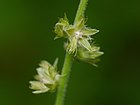Note: This is a project under development. The articles on this wiki are just being initiated and broadly incomplete. You can Help creating new pages.
Pupalia lappacea
Pupalia lappacea is a very variable plant. It can be annual or perennial, producing stems that can range in length from 50 - 200cm. Usually much branched, the plant is sometimes erect, but can also be prostrate and sprawling or even more or less climbing.
Contents
[hide]- 1 Uses
- 2 Parts Used
- 3 Chemical Composition
- 4 Common names
- 5 Properties
- 6 Habit
- 7 Identification
- 8 List of Ayurvedic medicine in which the herb is used
- 9 Where to get the saplings
- 10 Mode of Propagation
- 11 How to plant/cultivate
- 12 Commonly seen growing in areas
- 13 Photo Gallery
- 14 References
- 15 External Links
Uses
Coughs, Diarrhoea, Oedema, Constipation, Boils, Cuts, Snakebites, Syphilis, Sore-throat, Flatulence.[1]
Parts Used
Chemical Composition
Common names
| Language | Common name |
|---|---|
| Kannada | ಅಂಟುಪುರುಲೆ ಗಿಡ Antupurule gida |
| Hindi | Nagadamani |
| Malayalam | Pupalvalli |
| Tamil | Ottotti |
| Telugu | Erra uttareni, Tella uttareni |
| Marathi | |
| Gujarathi | Gadar jhipato |
| Punjabi | |
| Kashmiri | |
| Sanskrit | |
| English | Creeping cock's comb, Forest burr |
Properties
Reference: Dravya - Substance, Rasa - Taste, Guna - Qualities, Veerya - Potency, Vipaka - Post-digesion effect, Karma - Pharmacological activity, Prabhava - Therepeutics.
Dravya
Rasa
Guna
Veerya
Vipaka
Karma
Prabhava
Habit
Identification
Leaf
| Kind | Shape | Feature |
|---|---|---|
| Elliptic or Ovate | Acute | Pointed, Hairy, Base rounded |
Flower
| Type | Size | Color and composition | Stamen | More information |
|---|---|---|---|---|
| Ovate oblong | Greyish white | Bracts remain on the rachis after the flower falls. Flowering season is August-December | {{{5}}} |
Fruit
| Type | Size | Mass | Appearance | Seeds | More information |
|---|---|---|---|---|---|
| Utricle oblong | Fruiting season is August-December |
Other features
List of Ayurvedic medicine in which the herb is used
Where to get the saplings
Mode of Propagation
How to plant/cultivate
The plant is seen as a serious weed within its native range. The spiny, seed-containing burrs easily catch on passing animals, including people, and thus spread the plant to new locations.[5]
Commonly seen growing in areas
Savannah, Forest pathsides, Dry bushland.
Photo Gallery
References
- Jump up ↑ Indian Medicinal Plants by C.P.Khare
- Jump up ↑ [Chemistry]
- Jump up ↑ Common names
- Jump up ↑ Kappatagudda - A Repertoire of Medicianal Plants of Gadag by Yashpal Kshirasagar and Sonal Vrishni, Page No. 322
- Jump up ↑ Cultivation
External Links
- Ayurvedic Herbs known to be helpful to treat Coughs
- Ayurvedic Herbs known to be helpful to treat Diarrhoea
- Ayurvedic Herbs known to be helpful to treat Oedema
- Ayurvedic Herbs known to be helpful to treat Constipation
- Ayurvedic Herbs known to be helpful to treat Boils
- Ayurvedic Herbs known to be helpful to treat Cuts
- Ayurvedic Herbs known to be helpful to treat Snakebites
- Ayurvedic Herbs known to be helpful to treat Syphilis
- Ayurvedic Herbs known to be helpful to treat Sore-throat
- Ayurvedic Herbs known to be helpful to treat Flatulence
- Herbs with Leaves used in medicine
- Herbs with common name in Kannada
- Herbs with common name in Hindi
- Herbs with common name in Malayalam
- Herbs with common name in Tamil
- Herbs with common name in Telugu
- Herbs with common name in Gujarathi
- Herbs with common name in English
- Habit - Annual
- Index of Plants which can be propagated by Seeds
- Herbs that are commonly seen in the region of Savannah
- Herbs that are commonly seen in the region of Forest pathsides
- Herbs that are commonly seen in the region of Dry bushland
- Herbs



